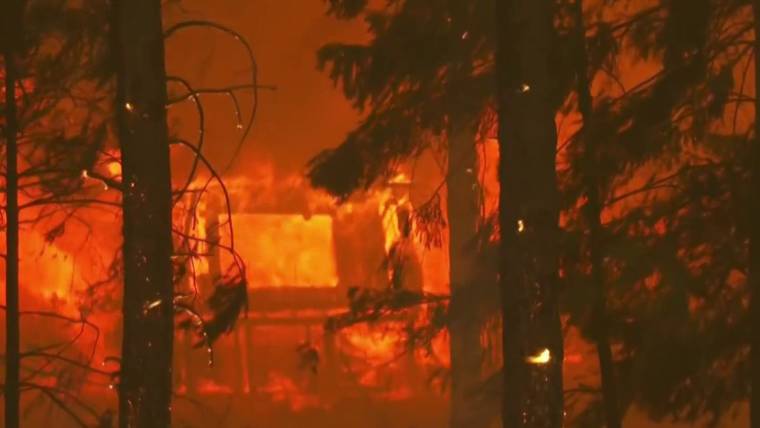Executives at troubled utility Pacific Gas & Electric, whose bankruptcy plan was just rejected by California Gov. Gavin Newsom for failing to address long-term safety issues, received millions in bonuses in recent years based in part on meeting safety goals, an NBC News investigation found.
State regulators have identified a years-long pattern of poor maintenance at PG&E that violated state regulations and led to the deadliest fire in California history, 2018’s Camp fire, which killed 85 people.
But from 2012 to 2017, PG&E paid its five top executives roughly $17 million in bonuses, including special payments for exceeding public and employee safety benchmarks, Securities and Exchange Commission filings show. Every year during that period, except 2016, PG&E’s executive pay was boosted by safety performance that the company said had exceeded its goals. During most of that period, the utility, which serves more than 5 million households in central and northern California, was paying off more than $1 billion in penalties and fines for the 2010 San Bruno pipeline explosion, which killed eight people.
The executives received the bonuses even in 2015, when two people died in a wildfire tied to its equipment.
PG&E’s board has historically reviewed the company’s safety performance each year, overseeing goals and policies “with respect to promoting a strong safety culture,” regulatory filings show.
In 2015, the year of the so-called Butte fire in which two people died, PG&E’s safety performance exceeded its targets, the filings show, and accounted for half of the bonus calculation, generating $4.3 million in incentive compensation to PG&E’s five top executives. “The Safety component was structured to provide a strong focus on the safety of employees, customers and communities,” the company said in the filings.
Let our news meet your inbox. The news and stories that matters, delivered weekday mornings.
Company financial performance also affects executives’ bonuses at PG&E, but instead of docking their pay for the costs of the San Bruno explosion, one of its biggest safety lapses, the company has removed more than $1 billion of those costs from its earnings calculations and thus the compensation equation in recent years. This translated into higher bonuses for executives between 2011 and 2018 than would have been paid if the costs had been part of the earnings and bonus arithmetic.
In 2015 alone, the company paid $578 million in fines but exempted this amount from the bonus math.
PG&E says in regulatory filings that it excludes certain costs from its bonus calculations that “do not reflect the normal course of operations.”
The practice of excluding the San Bruno fines and penalties from PG&E’s annual executive bonus calculations is controversial, some corporate governance experts said. “They are the captains of the ship and have to take some responsibility for it,” said Charles Elson, director of the John L. Weinberg Center for Corporate Governance at the University of Delaware. “You’re talking about a bonus payment — bonuses are for good conduct and this isn’t good.”
The former top executives at PG&E who received the bonuses either declined to comment, did not return phone calls or could not be reached.
In 2017, a year in which a series of wildfires killed dozens of people that regulators would later link to PG&E code violations, PG&E’s CEO and CFO did not receive bonuses. Last year, none of the company’s top brass received bonuses, following the Camp fire that leveled the town of Paradise and killed 85 people. Regulators blamed the fire on poor maintenance at a PG&E tower and power line.
‘An overall pattern’
PG&E has long maintained that safety is its top priority and it continues to do so. “Public and workforce safety is our most important responsibility at PG&E, and we take it very seriously,” a PG&E spokesman said in a statement to NBC News.
“PG&E’s compensation programs factor in the company’s safety performance across its operations — including power generation, gas and electric, as well as workforce safety throughout the company,” its spokesman said.
A recent report from California’s Public Utilities Commission, however, said that the utility’s maintenance shortcomings extended back years and were “indicative of an overall pattern of inadequate inspection and maintenance of PG&E’s transmission facilities.”
Since January, PG&E has been operating under chapter 11 protection after it was swamped by potential liabilities stemming from fires related to its equipment. The company recently struck a deal with its creditors, a group that includes fire victims, that would allow it to emerge from bankruptcy in 2020.
On Friday, Newsom objected to the utility’s proposed reorganization, saying it would not result in a company “positioned to provide safe, reliable, and affordable service” as required by state law, and citing “more than two decades … of failed efforts to improve its safety culture.”
Newsom called for “strict, clearly defined” safety measures at PG&E to hold the company accountable.
A PG&E spokesman said in a statement that the utility believes the restructuring plan satisfies California law “and is the best course forward for all stakeholders.” He said the company is working to resolve the issues raised by the governor.
Bonuses to PG&E executives have also come up in its bankruptcy case. In August, Judge Dennis Montali, who is overseeing the bankruptcy in San Francisco, rejected a company proposal to pay up to $16 million in bonuses to top executives. The judge said they should not require incentives to work on improving the utility’s safety and other performance.












